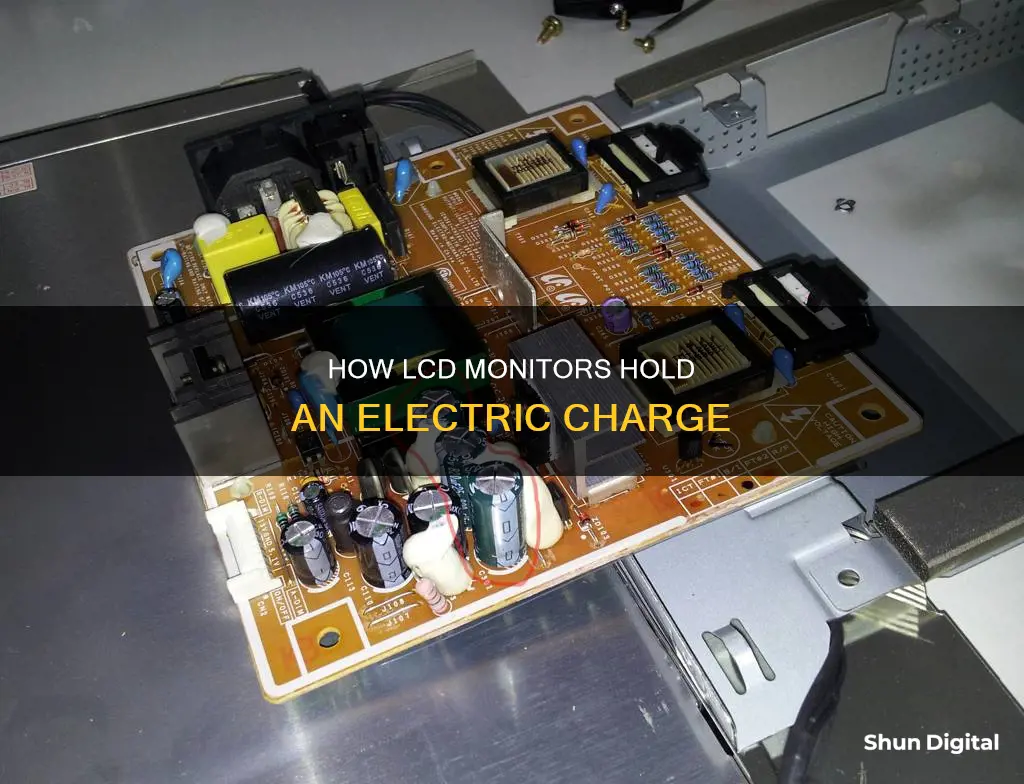
Liquid-crystal displays (LCDs) are a type of flat-panel display that uses liquid crystals and polarizers to display information. Unlike cathode-ray tubes (CRTs), LCDs do not emit light directly and require a backlight or reflector to produce images. LCDs are widely used in various devices, including laptop computers, digital clocks, watches, and televisions.
One key aspect of LCDs is their ability to block light. They consist of two pieces of polarized glass, or substrates, with a liquid crystal material between them. When an electrical current is applied, the liquid crystal molecules align, allowing varying levels of light to pass through and create images. This process involves controlling the amount of light that reaches the second substrate by adjusting the alignment of the liquid crystal molecules.
The performance of LCDs can be enhanced by using different types of backlights, such as LED or CCFL backlights. Additionally, the electrodes play a crucial role in controlling the behavior of liquid crystals and, consequently, the light behavior. The arrangement of electrodes and the alignment method used can impact the viewing angle, power consumption, and response time of the display.
While LCDs offer advantages such as reduced thickness, lower power consumption, and less heat emission compared to CRTs, they also have some limitations. These include issues with viewing angles, uneven backlighting, and challenges with achieving true black levels.
What You'll Learn

LCD monitors require an external light source
Liquid crystal display (LCD) technology works by blocking light. An LCD is made of two pieces of polarised glass (or substrate) that contain a liquid crystal material between them. A backlight creates light that passes through the first substrate. Electrical currents cause the liquid crystal molecules to align, allowing different levels of light to pass through to the second substrate and create colours and images.
LCDs do not produce light on their own and require an external light source to produce a visible image. This is provided at the back of the glass stack and is called a backlight. Active-matrix LCDs are almost always backlit, while passive LCDs may be backlit but many use a reflective surface or film at the back of the glass stack to utilise ambient light. Transflective LCDs combine the features of a backlit transmissive display and a reflective display.
The backlight technology used in LCDs can be either a white LED array, CCFL, EL-WLED, RGB-LED array, or Monochrome LEDs.
LCDs are used in a wide range of applications, including LCD televisions, computer monitors, instrument panels, aircraft cockpit displays, and indoor and outdoor signage.
Monitor Size: Helping Gamers Shoot Better?
You may want to see also

LCD monitors use a backlight
The backlight moves light through the back polarizer and back substrate into the liquid crystals. The light waves can behave in a variety of ways, depending on the alignment of the liquid crystal layer. This alignment can be altered by electrodes, which are placed differently within the structure for each type of alignment. The electrodes control the liquid crystal behaviour by conducting or not conducting a current into the crystal layer. This, in turn, affects whether light can pass through the liquid crystals and on to the polarizer.
The liquid crystal layer's purpose is to polarize the light so that it passes through to the surface of the display. By polarizing the light transmitted from the backlight, the liquid crystal molecules play a role in how much light passes through the polarizing filters.
Troubleshooting an ASUS Monitor Not Detecting HDMI on MacBook Pro
You may want to see also

LCD monitors use liquid crystal molecules
Liquid-crystal displays (LCDs) are flat-panel displays that use liquid crystals—substances that are neither solid nor liquid—to control how light passes through them. LCDs are made of two pieces of polarised glass (or substrate) that contain a liquid crystal material between them. This liquid crystal material is made up of liquid crystal molecules that are aligned between two glass substrates.
The process of how an LCD works begins with a backlight creating light that passes through the first substrate. Electrical currents then cause the liquid crystal molecules to align, allowing varying levels of light to pass through to the second substrate and create colours and images. The liquid crystal molecules act as light valves, allowing a certain amount of light to pass through them. The amount of light that passes through is determined by the amount of electrical current applied to the liquid crystal molecules.
The liquid crystal molecules are controlled by electrodes, which are placed differently within the structure depending on the method of alignment used. These electrodes are made of indium tin oxide (ITO) because of its good conducting properties and ability to be made into a transparent electrode. The placement of the electrodes within the structure determines properties of the display such as the width of the viewing angle, power consumption, and response time.
The liquid crystal layer's purpose is to polarise the light so that the polarised light passes through to the surface of the display. The light transmitted from the backlight is polarised by the liquid crystal molecules, which play a role in how much light passes through the polarising filters.
Choosing the Right Monitor Size for Comfortable Reading
You may want to see also

LCD monitors use polarizers
LCDs contain a lighting system that is responsible for illuminating their pixels. Some use light-emitting diodes (LEDs), while others use electroluminescent (EL) backlights. Regardless, all LCDs have a lighting system. A polarizer is a layer of light-filtering material placed between the backlighting and the LCD's pixel layer.
LCDs typically have two polarizers. They are made of a clear crystalline material and are designed to allow certain wavelengths of light while blocking others. The light produced by the LCD's lighting system must pass through the polarizers before reaching the pixel layer.
The polarizers work on the principle of polarization. The pixels in an LCD must project a specific level of brightness to create a visible image. LCDs are made up of millions of pixels, and to create an image, many of these pixels require varying levels of brightness. Polarizers allow LCDs to control the brightness of their pixels, resulting in the production of high-quality and visible images.
There are three types of polarizers: reflective, transmissive, and transreflective. Reflective polarizers are used in environments with bright ambient light, such as indoors and direct sunlight. Transmissive polarizers provide the brightest backlight but are difficult to read when the backlight is off. Transflective polarizers combine the functions of both reflective and transmissive polarizers, allowing the display to be readable whether the backlight is on or off.
The cost of the polarizer does not depend on its type but on the size of the glass. The larger the size of the glass, the higher the cost to build the display. When the glass size becomes too small, the cost of the module increases as the polarizer needs to be attached by hand, increasing labor costs.
Turning Off Timer on Your ASUS ROG Swift Monitor
You may want to see also

LCD monitors use electrodes
The liquid crystal layer in an LCD monitor is sandwiched between two pieces of polarised glass, also called substrates. Transparent electrodes are applied to the glass, and a voltage is applied across the liquid crystal layer to control the orientation of the molecules. This voltage causes the molecules to align in a way that allows varying levels of light to pass through the second substrate, creating the colours and images that we see.
The electrodes are made from a transparent conductive material, typically indium-tin oxide (ITO). The electrodes are arranged in a matrix on the glass, with rows and columns of electrodes intersecting at designated pixels. By controlling the voltage applied to specific pixels, the amount of light passing through can be modulated to create different levels of brightness and colour.
In a passive matrix LCD, a simple grid is used to supply the charge to a particular pixel. The rows or columns are connected to integrated circuits that control when a charge is sent down a particular column or row. However, this system has significant drawbacks, including slow response time and imprecise voltage control.
In an active matrix LCD, thin-film transistors (TFTs) are used to address individual pixels more precisely. To address a particular pixel, the proper row is switched on, and then a charge is sent down the correct column. The capacitor at the designated pixel receives the charge and holds it until the next refresh cycle. By carefully controlling the voltage supplied to each crystal, the amount of light passing through can be finely tuned to create a grey scale.
Through the precise control and variation of the voltage applied, the intensity of each subpixel can be adjusted to create a wide range of colours. By combining the three primary colours (red, green, and blue) for each pixel, a full-colour image can be displayed.
Choosing the Right Monitor: Size Considerations
You may want to see also
Frequently asked questions
LCD stands for Liquid Crystal Display. LCD screens are flat-panel displays that contain a layer of liquid crystal material within. This technology has largely replaced the previously popular Cathode Ray Tube (CRT) monitors.
LCD monitors require a light source, typically a backlight, to illuminate the display. The light passes through the liquid crystal layer, which is controlled by electrodes, and then through a polarizer to create the image we see on the display.
LCD monitors do not hold a charge. The liquid crystal layer within the monitor is controlled by electrodes, which conduct or do not conduct a current to align the liquid crystal molecules and create an image.
If your LCD monitor is not turning on or staying on, it could be due to faulty capacitors or a failing backlight. You may need to replace the capacitors or the backlight to fix the issue.
LCD monitors are thinner, lighter, and more energy-efficient than CRT monitors. They also do not suffer from screen burn-in like CRTs and have higher resolution, faster response times, and sharper images.







